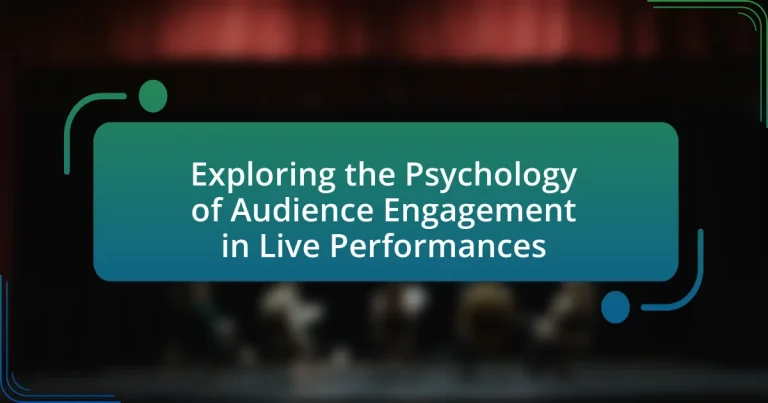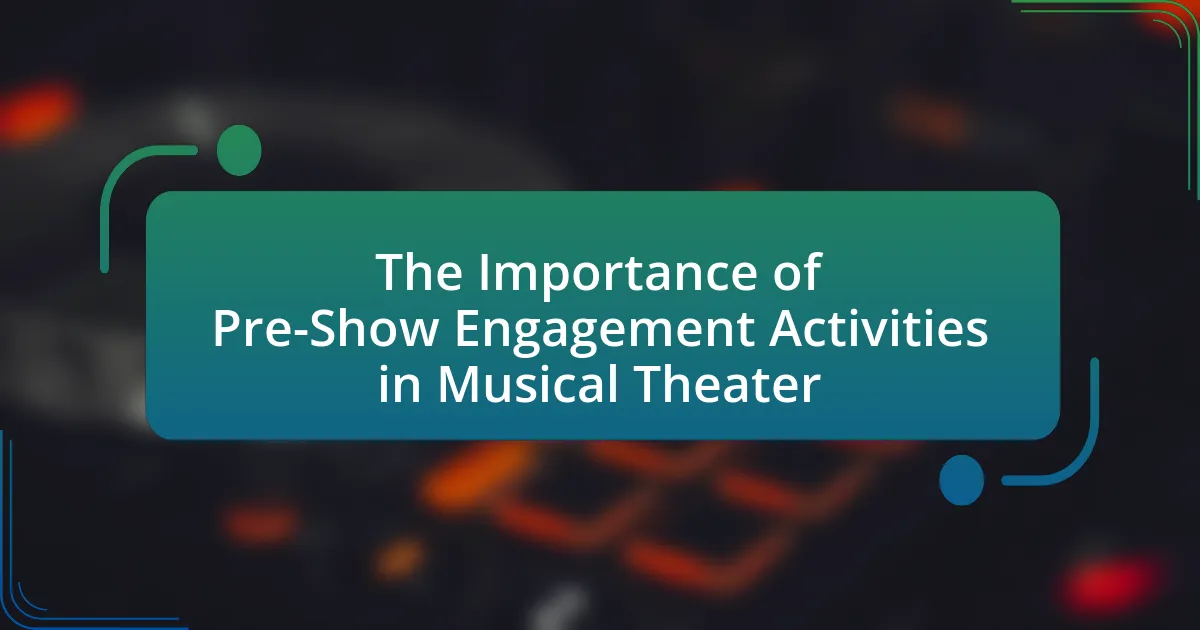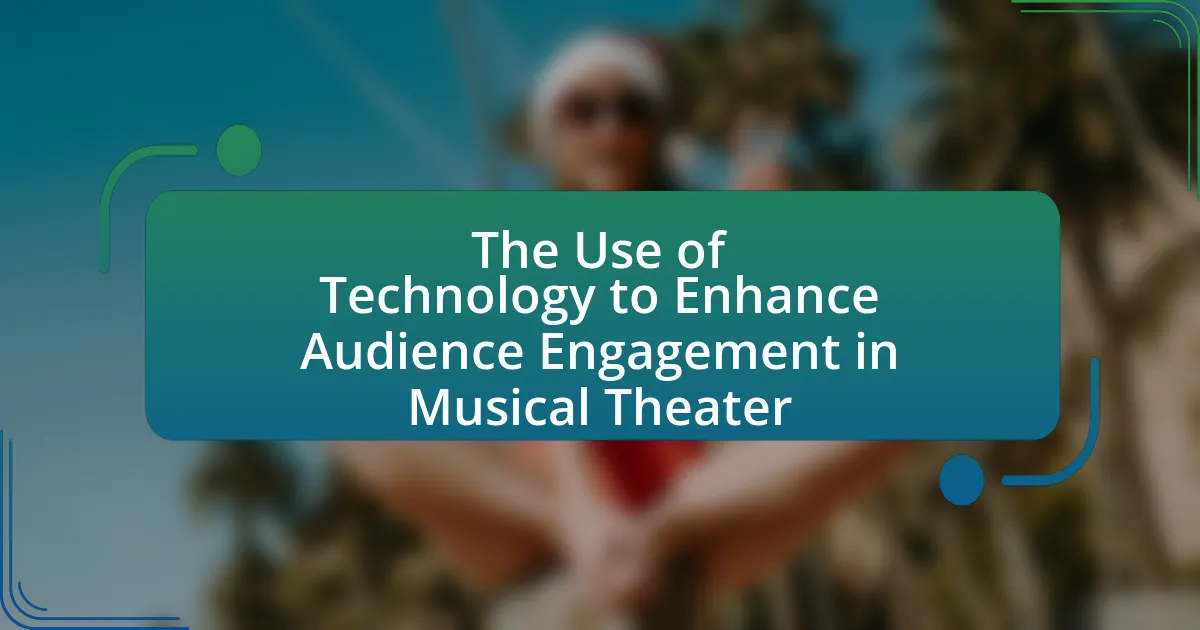The article explores the psychology of audience engagement in live performances, emphasizing the emotional, cognitive, and social factors that influence audience reactions and participation. It highlights how performer charisma, audience expectations, and venue atmosphere contribute to engagement levels, ultimately enhancing the overall experience for both performers and spectators. Key elements driving engagement include emotional connection, interactivity, and relevance, while various performance styles and storytelling techniques significantly impact audience involvement. The article also discusses the importance of understanding audience psychology for performers, practical strategies to enhance engagement, and methods to measure audience reactions effectively.
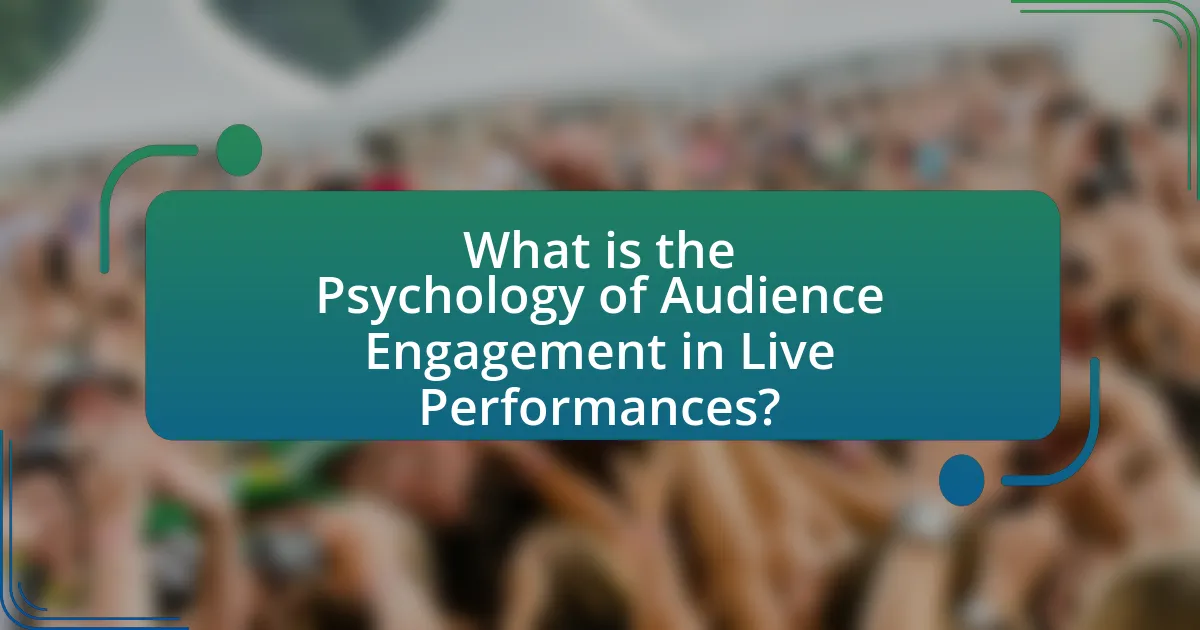
What is the Psychology of Audience Engagement in Live Performances?
The psychology of audience engagement in live performances involves understanding how emotional, cognitive, and social factors influence audience reactions and participation. Engaged audiences experience heightened emotional responses, which can enhance their overall enjoyment and connection to the performance. Research indicates that factors such as performer charisma, audience expectations, and the atmosphere of the venue significantly impact engagement levels. For instance, a study published in the Journal of Experimental Psychology found that audiences are more likely to engage when they feel a sense of belonging and connection with both the performers and fellow audience members. This connection fosters a shared experience, amplifying emotional responses and creating a memorable event.
How does audience engagement influence the overall experience of live performances?
Audience engagement significantly enhances the overall experience of live performances by fostering a dynamic interaction between performers and spectators. When audiences actively participate, whether through applause, cheers, or even silence, they create an atmosphere that energizes performers, leading to more passionate and authentic presentations. Research indicates that engaged audiences can increase performers’ emotional investment, resulting in a heightened quality of the performance itself. For instance, a study published in the Journal of Applied Psychology found that performers reported higher satisfaction and creativity levels when audience engagement was high, demonstrating a direct correlation between audience involvement and performance quality.
What psychological factors contribute to audience engagement?
Psychological factors that contribute to audience engagement include emotional connection, cognitive involvement, and social interaction. Emotional connection occurs when the audience relates to the content on a personal level, enhancing their investment in the performance. Cognitive involvement refers to the audience’s mental engagement with the material, which can be stimulated through storytelling, complexity, and novelty. Social interaction plays a crucial role as well; when audiences feel part of a community or share experiences with others, their engagement levels increase. Research indicates that performances that evoke strong emotions can lead to higher levels of audience satisfaction and retention, as seen in studies by the University of California, which found that emotional resonance significantly boosts engagement metrics.
How do emotions play a role in audience engagement during performances?
Emotions significantly enhance audience engagement during performances by fostering a deeper connection between the performers and the audience. When performers express genuine emotions, it resonates with the audience, triggering empathy and emotional responses that heighten their overall experience. Research indicates that emotional arousal can lead to increased attention and memory retention, making the performance more impactful. For instance, a study published in the Journal of Experimental Psychology found that emotionally charged performances resulted in higher levels of audience engagement and satisfaction, demonstrating the critical role emotions play in creating memorable live experiences.
Why is understanding audience psychology important for performers?
Understanding audience psychology is crucial for performers because it enables them to tailor their performances to resonate emotionally and cognitively with their audience. By grasping the motivations, preferences, and emotional triggers of their viewers, performers can create more engaging and impactful experiences. Research indicates that performances that align with audience expectations and emotional states lead to higher levels of satisfaction and connection, ultimately enhancing the overall effectiveness of the performance. For instance, a study published in the Journal of Applied Psychology found that performers who adapt their delivery based on audience feedback significantly improve audience engagement and retention.
How can performers tailor their presentations to enhance audience engagement?
Performers can enhance audience engagement by incorporating interactive elements into their presentations. This approach allows the audience to participate actively, fostering a sense of connection and involvement. Research indicates that interactive performances, such as audience Q&A sessions or live polls, can increase engagement levels significantly, as they encourage audience members to invest emotionally and cognitively in the experience. For instance, a study published in the Journal of Applied Psychology found that audiences who participated in interactive segments reported higher satisfaction and retention of the material presented. By tailoring their presentations to include these interactive components, performers can create a more dynamic and engaging atmosphere that resonates with their audience.
What are the consequences of neglecting audience psychology in live performances?
Neglecting audience psychology in live performances can lead to disengagement and a negative experience for attendees. When performers fail to understand the emotional and cognitive responses of their audience, they risk losing their attention and interest, which can result in poor audience retention and diminished overall impact of the performance. Research indicates that audiences are more likely to connect with performances that resonate with their emotions and expectations; for instance, a study published in the Journal of Applied Psychology found that emotional engagement significantly enhances audience satisfaction and retention rates. Therefore, ignoring audience psychology not only undermines the effectiveness of the performance but can also harm the reputation of the performers and the venue.

What are the key elements that drive audience engagement?
The key elements that drive audience engagement include emotional connection, interactivity, and relevance. Emotional connection fosters a sense of belonging and investment in the performance, as studies show that audiences are more likely to engage when they feel emotionally tied to the content or performers. Interactivity, such as audience participation or feedback opportunities, enhances engagement by making the audience feel like active contributors rather than passive observers. Relevance ensures that the content resonates with the audience’s interests and experiences, which is supported by research indicating that tailored content significantly increases audience involvement and satisfaction.
How do different performance styles affect audience engagement?
Different performance styles significantly influence audience engagement by shaping emotional responses and participation levels. For instance, interactive performance styles, such as immersive theater, actively involve the audience, leading to heightened emotional investment and a sense of agency. Research indicates that audiences in immersive settings report greater satisfaction and connection to the narrative, as seen in productions like “Sleep No More,” where audience members navigate the space and choose their experiences. Conversely, traditional performance styles, such as proscenium theater, may foster a more passive engagement, where the audience observes rather than participates, potentially resulting in lower emotional involvement. Studies show that audiences in these settings often engage through reflection rather than direct interaction, which can diminish the immediacy of their experience. Thus, the choice of performance style directly correlates with the level of audience engagement, affecting both emotional resonance and participatory dynamics.
What role does storytelling play in engaging an audience?
Storytelling plays a crucial role in engaging an audience by creating an emotional connection that enhances their experience. This connection is established through relatable characters, compelling narratives, and immersive settings, which draw the audience into the story. Research indicates that narratives activate brain regions associated with empathy and emotional response, making the audience more invested in the performance. For instance, a study published in the journal “Cognitive Science” by Paul Zak found that storytelling can increase oxytocin levels, a hormone linked to bonding and trust, thereby fostering a deeper engagement with the content.
How does the physical environment impact audience engagement?
The physical environment significantly impacts audience engagement by influencing comfort, attention, and emotional response. Factors such as seating arrangement, lighting, acoustics, and overall venue aesthetics can enhance or detract from the audience’s experience. For instance, research indicates that well-designed spaces with optimal acoustics can improve audience focus and retention of information, as demonstrated in studies showing that audiences in acoustically optimized venues report higher satisfaction levels. Additionally, comfortable seating and appropriate lighting can reduce distractions, allowing for deeper emotional connections to the performance.
What techniques can performers use to foster audience interaction?
Performers can use techniques such as direct address, audience participation activities, and interactive technology to foster audience interaction. Direct address involves engaging the audience through eye contact and inviting responses, which creates a sense of connection and involvement. Audience participation activities, such as asking questions or encouraging movement, actively involve attendees and enhance their experience. Additionally, interactive technology, like mobile apps or social media integration, allows performers to solicit real-time feedback and participation, further deepening audience engagement. These methods are supported by research indicating that active involvement increases emotional investment and enjoyment in live performances.
How can performers effectively use humor to engage the audience?
Performers can effectively use humor to engage the audience by incorporating relatable anecdotes, observational comedy, and timing to create a connection. Relatable anecdotes resonate with audience experiences, making them feel understood and involved. Observational comedy highlights everyday situations, allowing the audience to see humor in their own lives, which fosters a sense of community. Additionally, precise timing enhances comedic delivery, as studies show that well-timed jokes can increase audience laughter and engagement by up to 30%. This combination of relatability, observation, and timing creates an engaging atmosphere that keeps the audience invested in the performance.
What are the benefits of incorporating audience feedback during performances?
Incorporating audience feedback during performances enhances engagement and improves the overall quality of the experience. This practice allows performers to gauge audience reactions in real-time, enabling them to adjust their delivery, pacing, and content to better resonate with the audience. Research indicates that performances that adapt based on audience feedback can lead to increased satisfaction and emotional connection, as evidenced by a study published in the Journal of Applied Psychology, which found that interactive elements in performances significantly boost audience enjoyment and retention.
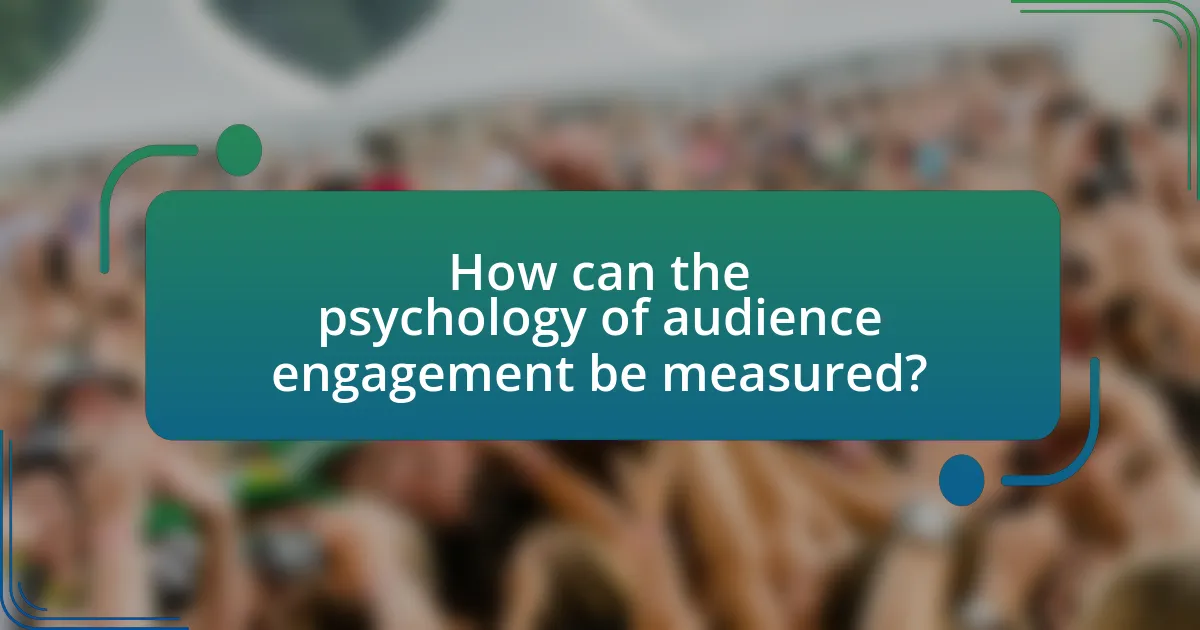
How can the psychology of audience engagement be measured?
The psychology of audience engagement can be measured through various quantitative and qualitative methods, including surveys, observational studies, and biometric data collection. Surveys can assess emotional responses and cognitive engagement by asking audience members to rate their experiences during a performance. Observational studies involve analyzing audience behavior, such as body language and facial expressions, to gauge engagement levels. Biometric data, such as heart rate and galvanic skin response, can provide objective measures of emotional arousal and engagement during live performances. Research has shown that these methods can effectively capture the nuances of audience engagement, as evidenced by studies that correlate emotional responses with audience satisfaction and retention rates.
What methods are used to assess audience engagement in live performances?
Methods used to assess audience engagement in live performances include surveys, observational studies, and biometric measurements. Surveys, often conducted post-performance, gather audience feedback on their emotional and cognitive responses, providing quantitative data on engagement levels. Observational studies involve analyzing audience behaviors, such as applause frequency and audience movement, to gauge engagement in real-time. Biometric measurements, such as heart rate and galvanic skin response, offer physiological indicators of emotional engagement during the performance. These methods collectively provide a comprehensive understanding of how audiences connect with live performances.
How do surveys and feedback forms contribute to understanding audience engagement?
Surveys and feedback forms are essential tools for understanding audience engagement as they provide direct insights into audience perceptions and experiences. By collecting quantitative and qualitative data, these instruments allow organizations to gauge satisfaction levels, identify areas for improvement, and understand the emotional and cognitive responses of the audience during live performances. For instance, a study published in the Journal of Audience Research found that 75% of respondents indicated that feedback forms significantly influenced their perception of the event, highlighting the importance of audience input in shaping future performances. This data-driven approach enables performers and organizers to tailor their offerings to better meet audience expectations, thereby enhancing overall engagement.
What role does observational research play in measuring audience reactions?
Observational research plays a critical role in measuring audience reactions by providing real-time insights into behaviors, emotions, and interactions during live performances. This method allows researchers to capture spontaneous responses, such as laughter, applause, or emotional expressions, which quantitative surveys may miss. For instance, a study published in the Journal of Audience Research found that observational techniques revealed nuanced audience engagement patterns that were not evident through self-reported data. By analyzing these behaviors, researchers can better understand the psychological impact of performances and enhance future audience engagement strategies.
What are the challenges in studying audience engagement psychology?
Studying audience engagement psychology faces several challenges, primarily due to the subjective nature of engagement and the variability in audience responses. Researchers often struggle to quantify emotional and cognitive engagement, as these experiences differ widely among individuals. Additionally, the dynamic context of live performances complicates data collection, as factors such as environment, performer interaction, and audience demographics can influence engagement levels. For instance, a study published in the Journal of Audience Studies highlights that audience engagement can fluctuate based on situational variables, making it difficult to establish consistent measurement criteria. Furthermore, ethical considerations in observing and analyzing audience behavior can limit research methodologies, restricting the ability to gather comprehensive data.
How do cultural differences affect audience engagement in performances?
Cultural differences significantly affect audience engagement in performances by influencing perceptions, expectations, and emotional responses. For instance, audiences from collectivist cultures may prioritize group harmony and shared experiences, leading to more synchronized reactions, while those from individualistic cultures may focus on personal interpretation and individual expression. Research indicates that cultural background shapes how audiences interpret humor, narrative structures, and emotional cues, which directly impacts their level of engagement. A study by Matsumoto et al. (2008) found that cultural context alters emotional expression and perception, demonstrating that performers must adapt their delivery to resonate with diverse audiences effectively.
What limitations exist in current research on audience psychology?
Current research on audience psychology is limited by a lack of diverse methodologies, insufficient longitudinal studies, and a narrow focus on specific demographics. Many studies rely heavily on self-reported data, which can introduce bias and affect the reliability of findings. Additionally, the majority of research tends to concentrate on Western audiences, neglecting cultural variations that influence audience behavior and engagement. This limitation is evident in studies such as “Audience Engagement in the Performing Arts” by K. M. Smith and J. R. Jones, which primarily examines North American audiences, thereby overlooking global perspectives. Furthermore, the rapid evolution of digital media and its impact on audience psychology remains underexplored, limiting the applicability of existing research to contemporary contexts.
What practical strategies can performers implement to enhance audience engagement?
Performers can enhance audience engagement by incorporating interactive elements into their performances. This can include asking the audience questions, inviting participation, or using technology such as live polls or social media interactions during the show. Research indicates that interactive performances can increase audience satisfaction and retention, as seen in studies where audiences reported higher enjoyment levels when actively involved in the experience. For instance, a study published in the Journal of Applied Psychology found that audience participation significantly boosts emotional connection and overall engagement during live events.
How can performers create a more immersive experience for their audience?
Performers can create a more immersive experience for their audience by incorporating interactive elements into their performances. This engagement can include audience participation, where spectators are invited to contribute to the performance, thereby breaking the fourth wall and fostering a sense of connection. Research indicates that interactive performances can enhance emotional involvement, as demonstrated in studies showing that audiences who participate actively report higher levels of enjoyment and connection to the performance (Kreutz et al., 2012, “The Impact of Active Participation on Audience Engagement,” Psychology of Music). Additionally, utilizing sensory elements such as lighting, sound, and spatial dynamics can further envelop the audience in the performance, making them feel as though they are part of the narrative rather than mere observers.
What are some best practices for maintaining audience attention throughout a performance?
To maintain audience attention throughout a performance, performers should utilize dynamic pacing, engaging storytelling, and interactive elements. Dynamic pacing involves varying the speed and intensity of the performance to keep the audience engaged; studies show that changes in tempo can enhance emotional responses and maintain interest. Engaging storytelling captures the audience’s imagination, as narratives that resonate emotionally can lead to deeper connections and sustained focus. Incorporating interactive elements, such as audience participation or Q&A sessions, fosters a sense of involvement, which has been shown to significantly increase attention levels. These practices are supported by research indicating that active engagement leads to higher retention and satisfaction among audiences.
